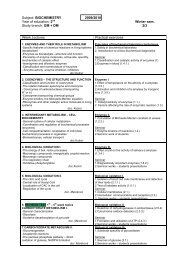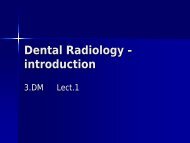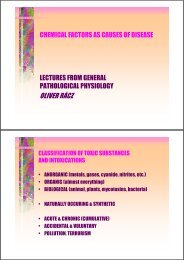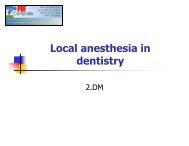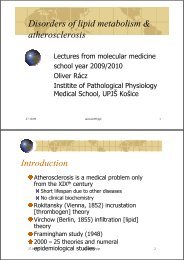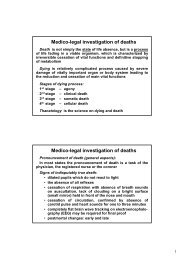disturbances of water & electrolyte metabolism part 1 - TOP ...
disturbances of water & electrolyte metabolism part 1 - TOP ...
disturbances of water & electrolyte metabolism part 1 - TOP ...
Create successful ePaper yourself
Turn your PDF publications into a flip-book with our unique Google optimized e-Paper software.
DISTURBANCES OF WATER &<br />
ELECTROLYT<br />
TROLYTE E METABOLISM<br />
PART 1 – WATER & SODIUM<br />
LECTURE<br />
FROM PATHOPH<br />
PHYSIOLOGY<br />
school<br />
ol year r 2009/2010<br />
OLIVER RÁCZ<br />
INST<br />
STITUTE OF PATHOPH<br />
PHYSIOLOGY,<br />
MEDICAL SCHOOL, UPJŠ KOŠICE<br />
2.10.2009 ellyte.ppt 1<br />
Ion<br />
Sodium<br />
ium, , Na +<br />
100-140 140 g<br />
4<br />
155<br />
2+ 1200 g<br />
2,5<br />
< 0,001<br />
2,5-3,5 mol<br />
2+<br />
30 molm<br />
(uneven)<br />
26,5 g<br />
1<br />
15<br />
Potassium, K +<br />
Calcium, Ca 2+<br />
Magnesium,<br />
Mg 2+<br />
Chloride,<br />
Cl -<br />
Phosphate<br />
(as phos<br />
osphorus)<br />
Amount in<br />
body<br />
92 g<br />
4 mol<br />
1,1 mol<br />
50 g<br />
1,4 molm<br />
775 g<br />
25 molm<br />
Plasma<br />
mmol/l<br />
141<br />
103<br />
1<br />
Cells<br />
mmol/l<br />
10<br />
8<br />
65<br />
2.10.2009 ellyte.ppt 2
Sodium<br />
– kitchen salt<br />
in our diet<br />
Europe 10 – 12 g/dg<br />
230 – 276 mmol/d<br />
Recommended 2 – 7 46 – 161<br />
Hypertonics < 3,5 80<br />
Strict vegetarians 0,75 17<br />
Ca & Mg deficid<br />
eficiencyency is frequent!<br />
Ca: 800 mg/d = 20 mmol/d<br />
the same for chidren and young<br />
gravidity & lactation – 1200 mg/d!<br />
Mg: 300 – 350 mg/d = 12-14 mmol/d<br />
more in puberty, gravidity, lactation<br />
& physical exercise<br />
USA: 143 – 266 mg/d<br />
2.10.2009 ellyte.ppt 3<br />
DISTRIBUTION OF WATER IN HUMAN<br />
BODY<br />
Com<strong>part</strong>ment<br />
ICS*<br />
ECS<br />
SUMMA<br />
ISF<br />
IVF<br />
Volume,<br />
litres<br />
28<br />
14<br />
42<br />
11<br />
3<br />
% <strong>of</strong> body<br />
mass<br />
40<br />
20<br />
60<br />
15,7<br />
4,3<br />
% <strong>of</strong> total<br />
<strong>water</strong><br />
67<br />
33<br />
100<br />
26<br />
7<br />
*10 14 cells<br />
Third space! small virtual volume, dynamic<br />
exchange – important in pathological conditions<br />
2.10.2009 ellyte.ppt 4
AGE<br />
newborn<br />
&<br />
3-66 mo. m<br />
7-12 mo. m<br />
adult man<br />
adult woman<br />
AGE DEPENDENCE OF FLUID<br />
HOMEOSTASIS<br />
TOTAL WATER,<br />
%<br />
79<br />
70<br />
60<br />
60<br />
51<br />
&<br />
ECS > ICS, danger <strong>of</strong> dehydratation<br />
In old age further ↓ & impaired adaptation,<br />
danger <strong>of</strong> dehydratation<br />
DAILY<br />
EXCHANGE, , %<br />
14-16<br />
16<br />
12-15<br />
15<br />
2-4<br />
2-4<br />
2.10.2009 ellyte.ppt 5<br />
BALANCE & DYNAMICS<br />
intake = output<br />
+ 1,2 – 1,5 beverage<br />
+ 1,0 food<br />
+ 0,3 – 0,5 <strong>metabolism</strong><br />
– 1,0 – 2,0 urine<br />
– 0,6 – 0,8 perspiration<br />
– 0,4 – 0,5 respiration<br />
– 0,1 stool<br />
2,5 – 3,0 liters/day<br />
KIDNEYS<br />
= 180 l/d<br />
GIT = 8,2 l/d<br />
<br />
<br />
<br />
<br />
<br />
saliva<br />
1,5<br />
stomach 2,5<br />
pancreas<br />
0,7<br />
bile 0,5<br />
guts 3,0<br />
THIRD SPACE<br />
2.10.2009 ellyte.ppt 6
OSMOLALITY &<br />
OSMOTIC GAP<br />
♣♠ ♣♠ ♣♠ ♣♠ ♣<br />
♣♠ ♣♠ ♣♠ ♣♠ ♣<br />
♣♠ ♣♠ ♣♠ ♣♠ ♣<br />
♣♠ ♣♠ ♣♠ ♣♠ ♣<br />
♣♠ ♣♠ ♣♠ ♣♠ ♣<br />
✽ ✽ ✽<br />
volume 5 l<br />
♣= 25 5,0/l<br />
♠= 25 5,0/l<br />
✽= 3 0,6/l<br />
∑ = 53 10,6/l<br />
Volume change (<strong>water</strong> loss)<br />
Canges in concentration <strong>of</strong> solutes<br />
without change <strong>of</strong> the amount!<br />
Compensatory mechanisms<br />
retention or excretion <strong>of</strong> ions<br />
adjustment <strong>of</strong> concentations<br />
Osmolality = 2*[Na] + [glucose] + [urea]<br />
OSMOLALITY &<br />
OSMOTIC GAP<br />
♣♠♣♠♣♠♣♠♣<br />
♣♠♣♠♣♠♣♠♣<br />
♣♠♣♠♣♠♣♠♣<br />
♣♠♣♠♣♠♣♠♣<br />
♣♠♣♠♣♠♣♠♣<br />
✽ ✽ ✽<br />
volume 4 l<br />
♣= 25 6,25/l<br />
♠= 25 6,25/l<br />
✽= 3 0,75/l<br />
∑ = 53 13,25/l<br />
Volume change (<strong>water</strong> loss)<br />
Canges in concentration <strong>of</strong> solutes<br />
without change <strong>of</strong> the amount!<br />
Compensatory mechanisms<br />
retention or excretion <strong>of</strong> ions<br />
adjustment <strong>of</strong> concentations<br />
Osmolality = 2*[Na] + [glucose] + [urea]
Loss <strong>of</strong> isotonic fluid<br />
<br />
<br />
<br />
<br />
<br />
<br />
<br />
<br />
<br />
<br />
<br />
Reduction <strong>of</strong> ECS, thirst<br />
no change <strong>of</strong> ICS<br />
normal plasma sodium<br />
Loss <strong>of</strong> hypotonic fluid<br />
<br />
<br />
<br />
<br />
<br />
<br />
<br />
<br />
<br />
<br />
Reduction <strong>of</strong> ECS.<br />
Hypernatremia compensated through <strong>water</strong> shift from ICS<br />
Shrinkage <strong>of</strong> cells
Salt loss<br />
<br />
<br />
<br />
<br />
<br />
<br />
<br />
<br />
<br />
<br />
<br />
Hyponatremia compensated through <strong>water</strong> shift from ECS<br />
into ICS,<br />
Reduction <strong>of</strong> ECS, swelling (oedema) <strong>of</strong> cells<br />
DISTURBANCES OF THE SYSTEM<br />
No pure forms – loss <strong>of</strong> <strong>water</strong>, salt...<br />
Immediate<br />
reaction <strong>of</strong> compen<br />
pensatory<br />
systems<br />
ECS<br />
is in contact both with external environment<br />
and<br />
with ICS<br />
ICS<br />
is in contact only with ECS<br />
Plasmatic concentrations are not amounts and does<br />
not inform on dynamics <strong>of</strong> compounds<br />
2.10.2009 ellyte.ppt 12
POSSIBLE CAUSES AND<br />
MECHANISMS<br />
<br />
<br />
<br />
Extreme<br />
deviations <strong>of</strong> external environment<br />
Dehydratation<br />
ation from insufficient <strong>water</strong> intake<br />
Disturbances caused by damaged function <strong>of</strong> effector<br />
systems (kidneys,, GIT, etc. c.)<br />
Diarrhoea, vomitus, kidney diseases<br />
Disturbances caused by erroneous regulation<br />
(CNS,<br />
ADH, aldosterone)<br />
Diabetes insipidus, Conn sy., SIADH<br />
Heart failure & RAA activation<br />
2.10.2009 ellyte.ppt 13<br />
DECREASED WATER INTAKE<br />
1 – 2 daysd<br />
ays: hyperosmotic hypovolemia<br />
thirst, compensated through ADH/RAA<br />
Pespiratio insensibilis 5 ml/hour<br />
↑ fever and in hot environment<br />
In old people and kidney diseases the<br />
concentrating capacity od kidneys is decreased<br />
Later: exsicosis, dehydratation, > 20 % death<br />
2.10.2009 ellyte.ppt 14
WATER DEFICIENCY – REDUCTION OF ECS<br />
Causes<br />
Insufficient fluid intake<br />
Inability to drink (loss <strong>of</strong> consciousness)<br />
Losses through GIT (diarrhoe, vomitus)<br />
Losses through kidneys<br />
(diuretics, osmotic diuresis<br />
esis, kideny diseases,<br />
m. Addison)<br />
Losses through skin (increased sweating, burns)<br />
Displacement into third<br />
place<br />
(ileus, ascites)<br />
Blood loss (?)<br />
Symptoms: hypotension<br />
sion, tachycardia<br />
ardia, dry skin, thirst,<br />
oliguria<br />
& decreased sodium excretion,<br />
increase <strong>of</strong> hematocrit<br />
2.10.2009 ellyte.ppt 15<br />
WATER RETENR<br />
ETENTIONTION – ECS EXPANSION<br />
Causes<br />
Increased fluid intake<br />
Increased intake & disturbed regulat<br />
ation<br />
– SIADH<br />
kidney failure<br />
nephrotic sy.<br />
heart failure<br />
liver cirrhosis<br />
Symptoms: Oedema.<br />
2.10.2009 ellyte.ppt 16
Hypernatraemia<br />
>150 / 160 mmol/l<br />
Low osmolality <strong>of</strong> urine – diabetes insipidus<br />
Osmolality <strong>of</strong> urine ≅ plasma – osmotic diuresis<br />
(diabetes mellitus)<br />
Osmolality y <strong>of</strong> urine > plasma – dehydratation<br />
ation<br />
diarrhoea, vomitus sweating<br />
Conn syndrome (hyperaldosteronism)<br />
hypernatremia<br />
mia, hypokalemia<br />
2.10.2009 ellyte.ppt 17<br />
Hyponatraemia<br />
20 mmol/l<br />
& hypovolemia<br />
m. Addison, diuretics<br />
salt losing neph<br />
phritis<br />
Na in urine < 20 mmol/l<br />
& hypovolemia<br />
diarrhoea, vomitus, , sweating with<br />
inadequate fluid replacement<br />
Na in urine < 20 mmol/l<br />
& oedema<br />
heart failure, cirrhosis<br />
osis, neph<br />
phrotic sy.<br />
SIADH<br />
2.10.2009 ellyte.ppt 18
DISTURBANCES OF ADH SECRETION<br />
AND EFFECTS – I.<br />
Diabetes insipidus, neurogenic<br />
(AD)<br />
AVP gene mutation<br />
Acquired forms – damage <strong>of</strong> hypothalamu<br />
alamus<br />
Complete e & <strong>part</strong>ial forms<br />
Diabetes insipidus, renal l (X-related & AR)<br />
Receptor (X) or <strong>water</strong> channel protein (AR)<br />
gene mutations<br />
Acquired – kidney diseases<br />
2.10.2009 ellyte.ppt 19<br />
DISTURBANCES OF ADH SECRETION<br />
AND EFFECTS – II.<br />
SIADH – inadequate<br />
secretion<br />
etion <strong>of</strong> ADH (lack(<br />
<strong>of</strong> suspension)<br />
Expansion <strong>of</strong> ECS<br />
hyponatremia<br />
mia, hypoosmolality<br />
High urine osmolality y & high Na in urine<br />
Increased ANP<br />
Renal & endocrin<br />
rine functions<br />
intact<br />
Hereditary forms and stress ??!!<br />
2.10.2009 ellyte.ppt 20
DISTURBANCES OF WATER &<br />
ELECTROLYT<br />
TROLYTE E METABOLISM<br />
PART 2 – POTASSIUM<br />
LECTURE<br />
FROM PATHOPH<br />
PHYSIOLOGY<br />
school<br />
ol year r 2009/2010<br />
OLIVER RÁCZ<br />
INST<br />
STITUTE OF PATHOPH<br />
PHYSIOLOGY,<br />
MEDICAL SCHOOL, UPJŠ KOŠICE<br />
2.10.2009 ellyte.ppt 21<br />
POTASSIUM HOMEOSTASIS<br />
<br />
<br />
<br />
<br />
<br />
<br />
Serum concentration: 3,8 – 5,5 mmol/l<br />
/l*<br />
Total amount depends on muscle mass<br />
(young > old; man > women<br />
en)<br />
37 – 52 mmol/kg<br />
body mass<br />
Intake: 2-66 g/d = 50-150<br />
mmol/d<br />
Excretion through kidneys 10 – 20 mmol/d<br />
(0,4 – 0,8 g/d).<br />
Inverse association with Na excretion<br />
GIT excretion isi<br />
important in kidney failure and<br />
in<br />
pathologic<br />
ological<br />
conditions (diarrhoea)<br />
*Depends on method. Preanalytic errors - hemolysis!<br />
2.10.2009 ellyte.ppt 22
FUNCTIONS OF POTASSIUM &<br />
INTERPRETATION OF RESULTS<br />
Functions<br />
intracellul<br />
lular osmotic pressure<br />
resting & action potential<br />
enzyme e activity, proteosynthesis<br />
Problems:<br />
1. assesment <strong>of</strong> cell homeostasis from extrace<br />
cellular<br />
concentration<br />
2. pH changes: exchange H/K between ECF/IC<br />
/ICF<br />
2.10.2009 ellyte.ppt 23<br />
INTERNAL & EXTERNAL BALANCE<br />
internal – ECF/ICF<br />
acidosis: H + enters the cells, K + out into ECF<br />
alkalosis<br />
osis: H + into ECF, , K + enters the cells<br />
K + entry into cells: : insul<br />
ulin (together with glucose),<br />
aldosterone, adrenaline<br />
rapid cellular proliferatiom (treatment <strong>of</strong> pernicious<br />
anaemia<br />
with B 12 vitamin<br />
cell necrosis, hemolysis (crush sy, malignancies),<br />
K + into<br />
ECF<br />
external – ECF/environment<br />
kidney or GIT retention/losses<br />
losses, parenteral intake<br />
dietary deficiency<br />
ency/excess as an additional factor<br />
2.10.2009 ellyte.ppt 24
HYPOKALAEMIA - SYMPTOMS<br />
<br />
<br />
<br />
<br />
<br />
<br />
hypokalaemia < 4,0 mmol/l<br />
significant < 3,5 mmol/l<br />
dangerous < 3,0 mmol/l<br />
Membrane hyperpolarih<br />
yperpolarisation<br />
<br />
Weakness, constipation, ileus, hypotonia<br />
Depression, confusion<br />
Arrhytmia, potentiation <strong>of</strong> digitalis toxicity<br />
ADH resistance, , polyuriap<br />
olyuria, polydipsia<br />
ECG flat/inversed T, , prolonged PR,<br />
ST depression, prominent U<br />
2.10.2009 ellyte.ppt 25<br />
HYPOKALAEMIA - CAUSES<br />
Disorders <strong>of</strong> external balance<br />
GIT – diarrhoea, vomitus, , tumors <strong>of</strong> colon, rectum,<br />
pancreas<br />
Kidneys - diuretics, polyuric stage <strong>of</strong> renal failure,<br />
hereditary tubulopathies,<br />
Primary<br />
ry & secondary hyperaldosteronism, , abuse <strong>of</strong><br />
liquorice, Cushing, ectopic ACTH production<br />
Glycyrrhiza glabra. Glycyrrhizin, , a sweet substance<br />
Weak corticomimetic<br />
omimetic & fitoestrogen effect<br />
Component <strong>of</strong> herb teas, nonalcoholic drinks and beer<br />
2.10.2009 ellyte.ppt 26
HYPOKALAEMIA - CAUSES<br />
Disorders <strong>of</strong> internal<br />
balance<br />
<br />
<br />
<br />
<br />
Treatment <strong>of</strong> diabetic hyperglycae<br />
caemia with insul<br />
ulin<br />
(K + entry into cells together with glucose)<br />
Alkalosis<br />
Rapid cellular proliferation<br />
Familiar hypokalaemic periodic paralysis (hereditary)<br />
2.10.2009 ellyte.ppt 27<br />
<br />
<br />
<br />
<br />
HYPERKALAEMIA - SYMPTOMS<br />
hyperkalaemia < 5,5<br />
mmol/l<br />
significant < 6,5<br />
mmol/l<br />
dangerous < 7,5<br />
mmol/l<br />
Low resting potential, short cardiac action potential,<br />
increased speed <strong>of</strong> repolarization <br />
Can kill without warning<br />
Ventricular fibrillation and cardiac arrest may be the first<br />
signs! (if you do not check K & ECG)<br />
ECG: abnormal/absent P; broad QRS,<br />
peaked T, T ST depression<br />
2.10.2009 ellyte.ppt 28
HYPERKALAEMIA - CAUSES<br />
Disorders <strong>of</strong> external<br />
balance<br />
Decreased excretion. Under GFR 15 ml/min always.<br />
Anuria: K increase 1 mmol/l dailyd<br />
In mild impairment <strong>of</strong> kidney function only when other<br />
factors are present<br />
Increased intake (infusions, NaCl substitution) only in the<br />
case <strong>of</strong> impaired kidney function<br />
m. Addison, adrenogenital sy.,<br />
inhibitor<br />
tors s <strong>of</strong> angiotensin<br />
converting<br />
enzyme<br />
2.10.2009 ellyte.ppt 29<br />
HYPERKALAEMIA - CAUSES<br />
Disorders <strong>of</strong> internal<br />
balance<br />
<br />
<br />
<br />
<br />
<br />
Acidosis<br />
Cell necrosis - rhabodmyolysis, , burns, cytostatic treatment<br />
<strong>of</strong> malignanacies<br />
Digitalis overdosis<br />
Hyperkalaemic periodic paralysis (hereditary)<br />
Malignant hypertermia (hereditary)<br />
2.10.2009 ellyte.ppt 30
DISTURBANCES OF WATER &<br />
ELECTROLYT<br />
TROLYTE E METABOLISM<br />
PART 3 – CALCIUM & MAGNESIUM<br />
LECTURE<br />
FROM PATHOPH<br />
PHYSIOLOGY<br />
school<br />
ol year r 2009/2010<br />
OLIVER RÁCZ<br />
INST<br />
STITUTE OF PATHOPH<br />
PHYSIOLOGY,<br />
MEDICAL SCHOOL, UPJŠ KOŠICE<br />
2.10.2009 ellyte.ppt 31<br />
CALCIUM<br />
<br />
<br />
<br />
Total body<br />
ECF<br />
Plasma<br />
1200 g 30 mol<br />
0,9 g 22,5 mmol<br />
0,36 g 9,0 mmol<br />
500 mmol/d<br />
25 mmol/d (1g)<br />
Bone / ECF exchange 500<br />
Daily losses 25<br />
<br />
<br />
urine 6 mmol (240 GF – 234 reabsorbtion)<br />
faeces 19 mmol (+25 food, 12 in, + 6 secr.)<br />
skin 0,3 mmol<br />
Small changes in fluxes can have pr<strong>of</strong>ound effect <strong>of</strong><br />
plasma Ca<br />
2.10.2009 ellyte.ppt 32
FUNCTIONS OF CALCIUM<br />
Structural<br />
Neuromuscular<br />
Blood<br />
Signal systems<br />
Bone, teeth<br />
Control <strong>of</strong> excitability;<br />
Neurotransmitter<br />
release<br />
Muscle contraction<br />
Coagulation (§(<br />
22)<br />
Messenger<br />
2.10.2009 ellyte.ppt 33<br />
PLASMA CALCIUM<br />
TOTAL<br />
2,25 – 2,60 mmol/l<br />
diffusible 54 % protein-bound 46 %<br />
free - ionized<br />
47 %<br />
7% complexed<br />
pH!<br />
CLINICAL CHEMISTRY: TOTAL OR IONIZED ?<br />
2.10.2009 ellyte.ppt 34
EC CALCIUM REGULATING HORMONES<br />
PTH & calcitriol! Calcitonin is <strong>of</strong> minor importance.<br />
Also regulation <strong>of</strong> phosphorus and perhaps magnesium<br />
o PTH – a 84 AA peptide from 115 AA precursor. AAs 1-<br />
34 are active<br />
o Short half life<br />
Calcitriol is a steroid hormone derived from vit. . D<br />
The 2 nd hydroxylation in liver is strictly controlled<br />
Calbindin D in gut<br />
Receptors in other tissues – role in cellular<br />
proliferation and differentiation and in immune<br />
response ?<br />
2.10.2009 ellyte.ppt 35<br />
FUNCTIONS OF PTH<br />
BONE<br />
Release <strong>of</strong> calcium<br />
Osteoclastic resorption<br />
KIDNEY<br />
Calcium reabsorbtion<br />
2 nd hydroxylation <strong>of</strong> vit.D<br />
Phosphaturia<br />
Decrease <strong>of</strong> HCO - 3 reabsorbtion<br />
.D ⇑ Ca, P<br />
⇑ [Ca 2+ ]<br />
⇑ [Ca 2+ ]<br />
Ca, P absorbtion<br />
⇓ [PO 4 ]<br />
⇓ pH<br />
2.10.2009 ellyte.ppt 36
HYPOCALCAEMIA - CAUSES<br />
Hypoparathyroidism<br />
Congenital (with Di George sy.)<br />
Acquired – autoimmune, surgery, hemochromatosis,<br />
tumors<br />
Pseudohypoparathyroidism<br />
2 hereditary disorders <strong>of</strong> PTH signaling pathway<br />
(cAMP<br />
dependent)<br />
Magnesium deficiency (pseudo ?)<br />
Deficiency <strong>of</strong> vitamin<br />
D (!)<br />
Disorders<br />
<strong>of</strong> vitamin<br />
D <strong>metabolism</strong> – end stage renal<br />
disease<br />
Acute pancreatitis, , transfusions with citrate, neonatal<br />
2.10.2009 ellyte.ppt 37<br />
HYPOCALCAEMIA - SYMPTOMS<br />
Stupor, numbness, paraesthesia<br />
Muscle cramps and spasms „tetany“<br />
Laryngeal stridor<br />
Convulsions<br />
Chvostek+ + Trousseau+, long QT on ECG<br />
Cataract in chronic hypocalcaemia<br />
Rickets (rachitis<br />
achitis) in vitamin D deficiency<br />
OSTEOPOROSIS ???<br />
2.10.2009 ellyte.ppt 38
HYPERCALCAEMIA - CAUSES<br />
COMMON (90%(<br />
<strong>of</strong> all)<br />
Primary hyperparathyroidism<br />
Malignancies – bone metastasis (?), PTHrP and other<br />
humoral factors<br />
<br />
<br />
<br />
LESS COMMON<br />
Thyreotoxicosis<br />
otoxicosis, sarcoidosis<br />
UNCOMMON<br />
Lithium treatment, tbc, immobilisation, , adrenal failure, renal<br />
failure, hereditary<br />
BUT ALSO HYPERPARATHYROIDISM WITHOT<br />
HYPERCALCAEMIA<br />
Compensatory in vitamin D deficiency, renal disease<br />
2.10.2009 ellyte.ppt 39<br />
HYPERCALCAEMIA - SYMPTOMS<br />
Weakness, tiredness, weight loss<br />
Imparied concentration, drowsiness (coma)<br />
Anorexia, nausea, vomiting, constipation<br />
Polyuria, , dehydration<br />
Renal calculi, nephrocalcinosis<br />
short QT, arrhytmias<br />
2.10.2009 ellyte.ppt 40
MAGNESIUM<br />
60 % in bones, higher in ICF than in ECF<br />
Only 0,3 % in blood, 30% protein bound<br />
Serum 0,7 – 1,0 mmol/l<br />
Regulator is not known! adre<br />
renal<br />
medulla, , insul<br />
ulin,<br />
parathormon n ???<br />
Regulated<br />
resorbtion<br />
from GIT ?<br />
8 mmol/d<br />
is enough ? Is deficiency common ?<br />
Excretion through urine and stool<br />
2.10.2009 ellyte.ppt 41<br />
MAGNESIUM<br />
Neuromuscular excitability (inhibition<br />
–<br />
mediated through decreased secretion <strong>of</strong><br />
acetylcholine?)<br />
Bone structure<br />
Enzyme activity, energy production,<br />
transport mechanisms, ribosomes<br />
Regulation <strong>of</strong> haemocoagulation and<br />
membrane function<br />
2.10.2009 ellyte.ppt 42
MAGNESIUM<br />
Cardioprotective antiischemic, antihypoxic<br />
effects<br />
Sedative effect on NS<br />
Antihypertensive<br />
Antithrombotic<br />
2.10.2009 ellyte.ppt 43<br />
MAGNESIUM<br />
Deficiency associated with soil and plant deficit Þ grass<br />
tetany <strong>of</strong> cattle<br />
Some drugs and stress can increase excretion<br />
Unhealthy diet (alcohol)<br />
High doses <strong>of</strong> calcium (!)<br />
CONSEQUENCES<br />
Spasmophilia is more <strong>of</strong>ten a consequence <strong>of</strong> Mg<br />
deficiency as <strong>of</strong> Ca<br />
Tiredness, irritability, tremor<br />
Dysmenorea, preeklampsia<br />
arrythmias<br />
2.10.2009 ellyte.ppt 44




